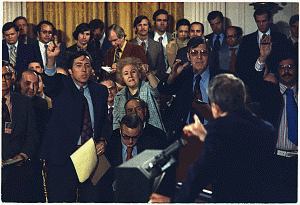Fifty years in housing: Part VIII
 NMA founder and president Nan McKay is celebrating a major milestone this year: her 50th year in housing. In an ongoing series of posts, she'll be sharing her stories of how the industry has changed over the course of decades.
NMA founder and president Nan McKay is celebrating a major milestone this year: her 50th year in housing. In an ongoing series of posts, she'll be sharing her stories of how the industry has changed over the course of decades.
Nan has previously written for the NMA blog on the topic of executive management and high performance achievement in the HCV program, and was recently profiled in the latest installment of our interview series.
- Part I: Interesting tidbits from 1937 to 1963
- Part II: Urban renewal on Concord Street
- Part III: The most exciting New Year’s Eve
- Part IV: Integrating Concord Street into the new highrise
- Part V: The men of the building
- Part VI: The women of the building
- Part VII: Public housing in the 1960s and 1970s
- Part VIII: The advent of Section 8
The advent of Section 8
The biggest change in subsidized housing occurred in the 1970s, following the enactment of the Section 23 Leased Housing Program in 1965. Under that program, qualified low-income tenants were placed in private units leased by local housing authorities. Tenants paid a portion of the rent, and the housing authorities paid the difference between what the tenants paid and what the building's owner might have received in the open market. The housing authorities also maintained the buildings. Although this program worked well, it was really just a forerunner to the program created by the Housing and Community Development Act of 1974 — Section 8.
There were several types of Section 8 housing. Section 8 New Construction and Section 8 Substantial Rehabilitation were major development and rehabilitation programs, usually owned and operated by the private sector. This type of Section 8 was project-based, in that the families under these programs had to live in the buildings. There was an Agreement to Enter into a HAP Contract (AHAP), which had to be approved by HUD prior to the start of construction or rehabilitation. When the building was ready for occupancy, a HAP contract was executed which was for all eligible Section 8 residents in the building.
It was a rent subsidy program for eligible families, and it became a very popular program. The units were either new, or substantial rehabilitation had been performed to bring them to a like-new condition. There was one problem: they were expensive to fund, because Congress provided enough funding for the life of the contract (between 20 and 40 years, depending on how they were financed). Note that at a later date, Congress required HUD to provide the "future funding" of the contracts back to the Treasury, leaving these projects on an annual funding cycle. The HUD rules for management of these contracts are in HUD Handbook 4350.3.
Another type of Section 8 was the Loan Management Set-Aside program. The LMSA program was developed by HUD primarily to provide financial assistance in the form of rental subsidies to multifamily properties subject to FHA-insured mortgage loans which are in immediate or potential financial difficulty, thereby reducing the volume of mortgage loan defaults as well as claims for FHA mortgage insurance benefits.
For example, if an owner had a Section 236 project (a property financed via an FHA below-market interest rate loan guarantee) and the rents over time had become unaffordable for low-income residents, HUD would add a Section 8 LMSA commitment to preserve the viability of the project. The Section 8 LMSA allowed families to pay a portion of their income instead of a fixed unit rent.
A similar use of Section 8 was to convert Rental Assistance Payment (RAP) subsidies and Rent Supplement subsidies in primarily privately-owned buildings to Section 8. Again, this ensured project viability for ongoing affordability.
This personal description of housing isn't meant to be
an all-inclusive timeline. For more details, you might find
Lawrence L. Thompson's A History of HUD interesting.
Most of these types of Section 8 did not affect PHAs. Exceptions were where the PHA was either the developer (very rare) or the contract administrator of a privately-owned Section 8 New Construction or Substantial Rehabilitation building. This usually happened when the PHA either had an interest in the ownership of the property or the financing of the building.
Two Section 8 programs did make a huge impact on PHAs: Section 8 Moderate Rehabilitation and Section 8 Certificates. Section 8 Mod Rehab was project-based, but had a fatal flaw: the rehabilitation which was usually needed wasn't "moderate," it was substantial. And the funding wasn't there for substantial rehab. Although some mod rehab contracts remain, most PHAs do not consider this a successful program. (The new Rental Assistance Demonstration (RAD), launched last year, is an opportunity for PHAs to convert units assisted by the public housing and Mod Rehab programs to long-term Section 8 rental assistance contracts.)
The subsidy program which had the biggest impact on PHAs over time was the certificate (which later became the voucher) program. Why? Think about it. Prior to this program, families had to live in a project to be eligible for subsidy in a PHA program. Much of the public housing for families in large cities didn't have a great reputation. The projects, as they were referred to, were identifiable in several ways. Buildings had the "look" of public housing. Most businesses knew the address when it was given, which affected residents negatively when they tried to get credit in the community. There was a stigma attached to public housing,
even if you were a great tenant.
The certificate program freed families from the public housing stigma. They didn't have to live in the projects, or use the address of the projects. Instead, they could actually choose where they wanted to live and still be subsidized. Some families chose units in the same neighborhood because they wanted to be close to family and friends. Some families were scared to leave public housing because they learned that if they didn't follow the family obligations, they could be terminated — the private-owner program seemed stricter than public housing. But, overall, the certificate program provided a freedom that families had never before experienced.
Where was I during this transition? In 1970, Molly McKay was born. I worked in the elderly highrise for several years. For some of this time, I was able to bring Molly to the highrise (where she had 132 grandmas and grandpas). In 1972, John McKay was born, and I decided to work part-time, putting together an organizational transcript to bring a new county housing authority into existence (upon request by the county board), providing consulting to the elderly highrise's housing authority, and writing a book, Creating Positive Performance.
In 1973, President Nixon put a housing moratorium in effect. Congress was concerned about the costs, effectiveness, and manageability of HUD's major programs, and funding for many of HUD's programs was halted. It was a major blow to some PHAs, including the county I was working for, which was now on record and had submitted funding applications. However, there was no choice but to wait out the moratorium. Fortunately, the Housing and Community Development Act of 1974 effectively ended the moratorium, and Section 8 housing was born.
While serving as executive director of a Minnesota housing authority, Nan McKay started one of the nation’s first Section 8 programs. She has devoted the past two years to redesigning NMA’s HCV Executive Management course and rewriting the HCV Executive Management Master Book.


